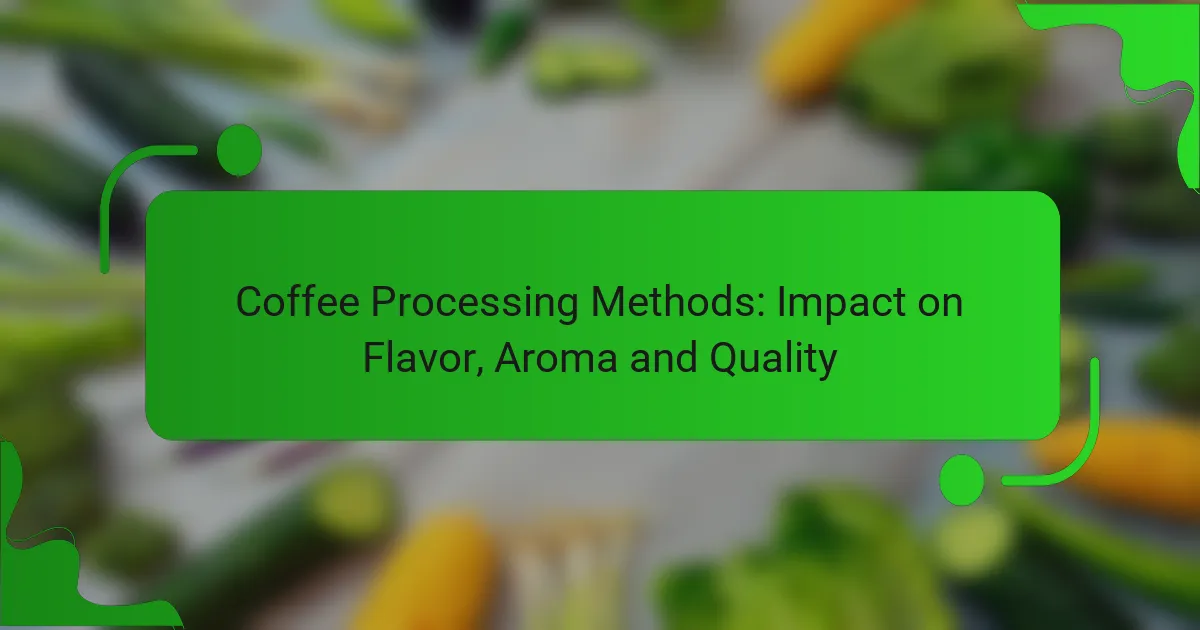Coffee processing methods play a crucial role in shaping the flavor, aroma, and overall quality of coffee beans, making them essential for enthusiasts and connoisseurs alike. Techniques such as washed, natural, and honey processing each impart unique characteristics, influencing taste elements like acidity and sweetness. Understanding these methods allows consumers to appreciate the diverse profiles and qualities that different coffees can offer.

How do coffee processing methods affect flavor in Los Angeles?
Coffee processing methods significantly influence the flavor profiles of coffee beans, which is particularly relevant for coffee enthusiasts in Los Angeles. The choice of processing technique can enhance specific taste characteristics, such as acidity, sweetness, and balance, ultimately affecting the overall quality of the brew.
Washed processing enhances acidity
Washed processing, also known as wet processing, involves removing the coffee cherry’s outer fruit layer before fermentation. This method typically results in a cleaner cup with bright acidity, making it a popular choice among coffee drinkers who appreciate vibrant flavors. In Los Angeles, where specialty coffee culture thrives, washed coffees are often sought after for their crisp and fruity notes.
During the washing process, beans are fermented in water, which helps to remove mucilage and impurities. This can lead to a more pronounced acidity, which is often described as lively or sparkling. However, it’s essential to monitor fermentation times closely, as over-fermentation can introduce undesirable flavors.
Natural processing increases sweetness
Natural processing, or dry processing, involves drying the whole coffee cherry in the sun before removing the outer layers. This method allows the beans to absorb sugars from the fruit, resulting in a sweeter and more complex flavor profile. In Los Angeles, natural coffees are appreciated for their rich, fruity characteristics and full-bodied mouthfeel.
While natural processing can enhance sweetness, it requires careful attention to drying conditions to prevent fermentation issues. Ideal drying conditions include consistent sunlight and low humidity, which help maintain the quality of the beans. Coffee lovers in Los Angeles often enjoy exploring the unique flavors that natural processing can offer.
Honey processing balances flavor profiles
Honey processing is a hybrid method that combines elements of both washed and natural processing. In this technique, some of the mucilage is left on the beans during drying, which contributes to a balanced flavor profile with both sweetness and acidity. This method has gained popularity among Los Angeles coffee roasters looking to create distinctive blends.
Depending on the amount of mucilage retained, honey processing can yield varying flavor outcomes, from light and fruity to rich and syrupy. This versatility allows for a wide range of tasting experiences, making honey-processed coffees a favorite among those who enjoy experimenting with different flavor notes. When selecting honey-processed coffee, consider the specific variety and processing style to find the best match for your palate.

What are the common coffee processing methods?
The common coffee processing methods include washed, natural, and honey processing. Each method significantly influences the flavor, aroma, and overall quality of the coffee, affecting how the beans are perceived by consumers.
Washed processing
Washed processing, also known as wet processing, involves removing the coffee cherry’s outer fruit layer before fermentation. This method typically results in a cleaner and brighter flavor profile, highlighting the beans’ inherent characteristics.
The process includes depulping the cherries, fermenting the beans in water to remove mucilage, and then washing them thoroughly. This method is popular in regions with abundant water supply, such as Colombia and Costa Rica.
While washed processing can enhance acidity and clarity, it may also lead to a loss of some fruity flavors. Producers should ensure proper fermentation times to avoid off-flavors.
Natural processing
Natural processing, or dry processing, involves drying the whole coffee cherries in the sun before removing the outer layers. This method often results in a fuller body and more pronounced fruity flavors, as the beans absorb sugars from the fruit during drying.
This technique is commonly used in regions with limited water resources, such as Ethiopia and Brazil. The cherries are spread out on drying beds or patios and turned regularly to prevent spoilage.
Natural processing can lead to inconsistent quality if not monitored carefully. Producers should be cautious of over-fermentation and ensure even drying to maintain flavor integrity.
Honey processing
Honey processing is a hybrid method that combines elements of both washed and natural processing. In this technique, some of the mucilage is left on the beans during drying, which can enhance sweetness and complexity in the final cup.
Honey processing can yield a range of flavor profiles depending on how much mucilage is retained. Producers should experiment with different levels of mucilage to find the desired balance between sweetness and acidity.

How does processing impact aroma in coffee?
The processing method used for coffee beans significantly influences their aroma. Different techniques can enhance or diminish specific aromatic compounds, leading to distinct flavor profiles that appeal to various preferences.
Washed processing produces clean aromas
Washed processing, also known as wet processing, involves removing the coffee cherry’s outer fruit before fermentation. This method typically results in a cleaner and brighter aroma, allowing the inherent characteristics of the bean to shine through.
During washed processing, the beans are fermented in water, which helps to eliminate mucilage and other impurities. This results in a cup that often features floral and citrus notes, making it a popular choice among coffee enthusiasts who prefer clarity in flavor.
Natural processing offers fruity aromas
Natural processing, or dry processing, involves drying the whole coffee cherry before removing the fruit. This method tends to produce a more complex and fruity aroma, as the beans absorb flavors from the cherry during the drying process.
With natural processing, you can expect flavors reminiscent of berries, stone fruits, and even wine-like qualities. However, this method can also lead to inconsistencies in quality, as the drying process must be carefully monitored to prevent over-fermentation.

What is the impact of coffee processing on quality?
The processing method significantly influences the overall quality of coffee, affecting its flavor, aroma, and body. Different techniques can enhance or diminish specific characteristics, leading to a wide range of taste profiles and quality grades.
Processing method affects cup quality
The primary coffee processing methods—washed, natural, and honey—each impart distinct flavors and aromas to the final cup. For instance, washed coffees typically have a cleaner taste with bright acidity, while natural coffees may exhibit fruity and wine-like qualities due to the drying of the cherry with the fruit intact.
When selecting coffee, consider how the processing method aligns with your flavor preferences. Experimenting with various methods can help you identify which profiles you enjoy most, as the choice of processing can lead to noticeable differences in taste and aroma.
Quality grading based on processing
Coffee quality is often graded based on the processing method used, among other factors. Specialty coffee, which adheres to strict quality standards, typically comes from beans processed using meticulous methods that enhance flavor clarity and complexity.
Grading systems may vary by country, but many rely on cupping scores that assess attributes like acidity, sweetness, and aftertaste. Understanding these grading systems can help you make informed purchasing decisions, ensuring you select high-quality coffee that meets your taste expectations.

How to choose the right coffee processing method for your business?
Selecting the appropriate coffee processing method is crucial for influencing the flavor, aroma, and overall quality of your coffee. Consider factors such as your target flavor profiles and local market preferences to make an informed decision that aligns with your business goals.
Consider target flavor profiles
Understanding your desired flavor profiles is essential when choosing a coffee processing method. Different methods, such as washed, natural, or honey processing, can significantly alter the taste and aroma of the final product. For instance, washed coffees tend to have a cleaner taste, while natural coffees often exhibit fruity and complex flavors.
To align processing methods with flavor goals, conduct tastings and gather feedback from potential customers. Aim for a balance between unique flavor characteristics and consistency, as this can help establish a loyal customer base.
Evaluate local market preferences
Local market preferences play a vital role in determining the best coffee processing method for your business. Research the tastes and trends within your target demographic to ensure your offerings resonate with consumers. For example, markets that favor specialty coffee may appreciate unique processing methods that enhance flavor complexity.
Consider conducting surveys or focus groups to gauge consumer preferences. Additionally, staying informed about regional coffee trends can help you adapt your processing choices to meet evolving market demands, ultimately enhancing your competitive edge.

What are the environmental impacts of coffee processing?
Coffee processing significantly affects the environment through water consumption and waste generation. Different methods, such as washed and natural processing, have distinct environmental footprints that impact local ecosystems and communities.
Water usage in washed processing
Washed processing, also known as wet processing, requires substantial water to remove the coffee cherry’s mucilage. This method can use anywhere from 20 to 100 liters of water per kilogram of coffee produced, depending on the efficiency of the processing facility.
Excessive water usage can lead to depletion of local water sources, particularly in regions facing water scarcity. Implementing water recycling systems and using less water-intensive methods can mitigate these impacts.
Waste management in natural processing
Natural processing involves drying the coffee cherries with their fruit intact, which generates significant organic waste. The leftover pulp and mucilage can create pollution if not managed properly, as they decompose and release harmful substances into the environment.
To manage waste effectively, coffee producers can compost the byproducts or use them as organic fertilizers. This not only reduces environmental impact but also enhances soil health, promoting sustainable farming practices.

What are emerging trends in coffee processing methods?
Emerging trends in coffee processing methods focus on sustainability, specialty flavors, and technological advancements. These trends reflect a growing consumer interest in both the environmental impact of coffee production and the unique taste profiles that various processing techniques can create.
Innovations in eco-friendly processing
Eco-friendly coffee processing methods emphasize sustainability and minimal environmental impact. Techniques such as wet processing with water recycling, dry processing that reduces water usage, and organic farming practices are gaining traction. These methods not only help preserve natural resources but also appeal to environmentally conscious consumers.
For instance, some producers are adopting anaerobic fermentation, which uses less water and enhances flavor complexity. This method can lead to unique taste profiles while being more sustainable than traditional wet processing.
Consumer demand for specialty processing
As consumers become more discerning, there is a rising demand for specialty coffee processing methods that enhance flavor and aroma. Techniques like honey processing and natural processing are popular for their ability to create distinct taste profiles that stand out in the market. These methods often result in coffees with fruity or floral notes, attracting coffee enthusiasts.
Producers are responding by experimenting with various processing techniques to differentiate their products. This trend encourages small-scale farmers to explore unique methods that can yield higher prices in specialty markets.
Impact of technology on processing efficiency
Technology is transforming coffee processing by improving efficiency and consistency. Innovations such as automated sorting machines and advanced fermentation tanks allow producers to maintain quality while reducing labor costs. These technologies can streamline operations and enhance the overall processing experience.
Additionally, data analytics tools help farmers monitor and optimize processing conditions, leading to better flavor outcomes. By leveraging technology, producers can meet the growing demand for high-quality coffee while ensuring sustainable practices.



